
Introduction
It was quite a while ago,
back in June of this year, that we first brought you the news of a new 23"
monitor in NEC's 'Office Cool' range of screens. The release has actually been
held back a little but the screen is now finally emerging in the market and we
are some of the first to have a hands on experience with it.
“The minimalistic appearance of the
EX231Wp is a perfect match for the modern office, a core
aspect of the Office Cool ethos. We have focused on making the display the
dominant part with minimalist lines and a very slim frame, but without
sacrificing quality or usability. The LED backlighting not only helps create a
slimmer and lighter display, but also allows for very low energy consumption,”
said Birgit Sommerer, Product Line Manager for Commercial Displays at NEC
Display Solutions Europe.
“The ultra-slim MultiSync EX231Wp was created
to enhance the office environment, giving business users more functionality with
the ability to easily implement web conferencing, small-scale digital signage,
portability in between meetings and simple multi-screen setup.”
Interestingly this new EX231Wp marks a move by NEC
away from IPS panel technology which had been widely used in their monitor range
for many years. NEC already have the 23"
EA232WMi which is their alternative model of this size using IPS and W-LED
backlighting. This new model uses one
of Samsung's new cPVA panels. We have tested one of the earlier generations of
cPVA panel when we reviewed the
Samsung F2380, and so it will be interesting to see if some of the
impressive performance characteristics we saw in some areas from that model
carry over to this NEC offering and whether it can improve on some of the other
areas where we were not as impressed.
The EX231Wp is marketed on NEC's website as
offering an "Ultra-slim ‘Office Cool’ design, combining MultiSync trusted
performance and quality with new standards of minimalism and Eco Innovation. A
23” wide PVA TFT LED Backlit display, ideal for the corporate that demands
style, future proof technology and excellent picture quality with wider viewing
angles."

Specifications and Features
The following table gives detailed information
about the specs of the screen:
|
Monitor
Specifications |
|
Size |
23"WS (58.42 cm) |
Colour Depth |
16.7m |
|
Aspect Ratio |
16:9 |
Colour Gamut |
Standard gamut, ~sRGB |
|
Resolution |
1920 x 1080 |
Panel Coating |
Anti-glare |
|
Pixel Pitch |
0.265 mm |
Interfaces |
1x DVI-I (HDCP), 1x DisplayPort |
|
Response Time |
25ms (Typ) |
Design
colour |
Matte black bezel and stand |
|
Static Contrast Ratio |
3000:1 |
Ergonomics |
Tilt,
swivel, 110mm height, pivot |
|
Dynamic Contrast Ratio |
25,000:1 |
Special
Features |
1x
USB 2.0 ports |
|
Brightness |
250 |
VESA Compatible |
Yes |
|
Viewing Angles |
178/178 |
Physical Dimensions |
(WxHxD landscape orientation, lowest height adjustment)
474.8 x 381.1 x 215 mm |
|
Panel Technology |
cPVA |
Weight |
With stand:
3.5kg
Without stand: 2.2kg |
|
Backlight Technology |
W-LED |
Accessories |
DVI to DVI cable, VGA to DVI cable, USB cable, power supply. Cable tidy clip and AC adapter holders |
Note: NEC's UK website lists the
contrast ratio of this model as 1000:1 whereas their USA website lists it as
3000:1. I have verified with NEC that the 3000:1 figure is correct, which you
will also be able to see from our independent tests.
The EX231Wp offers a fairly basic set of PC
connections, with a single DVI-I and DisplayPort available. The DVI connection
can handle analogue signals from a D-sub output (via a converter or the supplied
VGA > DVI cable) as well but it
would have been nice to see a separate D-sub connection here I think so you can
connect two PC's and easily switch between them. The
DisplayPort presence is welcome given the trend towards this connection from
external devices and graphics cards. Sadly there is no HDMI though which is also
widely used. The digital DVI-I port supports HDCP as well. The screen is packaged
with a cable for DVI > DVI and VGA > DVI, but a DisplayPort cable could have been useful seeing as
the screen offers a DisplayPort connection too.
NEC have included a single USB 2.0 port on the top
of the screen which is useful for connecting external devices. It would have
perhaps been good to have some further ports available too. There is no card
reader which can be found on some models (e.g. Dell U2410). NEC have included an
ambient light sensor for auto-brightness adjustment as well as a human sensor
which controls the screens power profile when it detects no one is using it. We
will talk about this more later.
Below is a summary of the features and connections of
the screen:
|
Feature |
Yes / No |
Feature |
Yes / No |
|
Tilt adjust |
 |
DVI |
 |
|
Height adjust |
 |
HDMI |
 |
|
Swivel adjust |
 |
D-sub |
 |
|
Rotate adjust |
 |
DisplayPort |
 |
|
VESA compatible |
 |
Component |
 |
|
USB Ports |
 |
Composite |
 |
|
Card Reader |
 |
Audio connection |
 |
|
Ambient Light Sensor |
 |
HDCP Support |
 |
|
Touch Screen |
 |
Integrated Speakers |
 |
|
Human Sensor |
 |
Touch sensitive controls |
 |


Design and Ergonomics

Above:
front view of the EX231Wp
The screen is an all black design, with matte plastics
in all areas. There is a very thin bezel which measures only 14mm along all
sides which is attractive. In the top right hand corner is a "MultiSync
EX231Wp" logo and the top left features NEC's logo. The OSD operational
buttons are located in the right hand corner which we will look at more in a
moment.

Above: rear
view of the screen
The back of the screen is again a matte black
colour and nicely squared off and enclosed. The stand clips simply in to place
within the square area you can see above. This comes packaged separately but
is easy to install. The base is also packaged separately but screws easily in
to place. The back of the screen above where the stand clips can
also act as a carry handle which is useful if you are ever moving the screen
around.
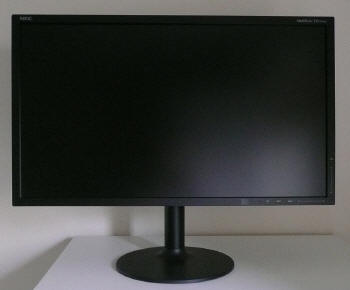
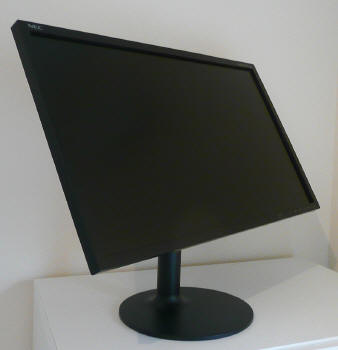
Above:
front views of the screen. Click for larger versions
The coating of the screen is a
normal Anti-glare option as opposed to any glossy solution. This shows some
slight graininess but does not appear to be as noticeable as some modern IPS
panels for instance. This is not something which has ever really bothered me,
and on this screen I can't see it being a big issue.
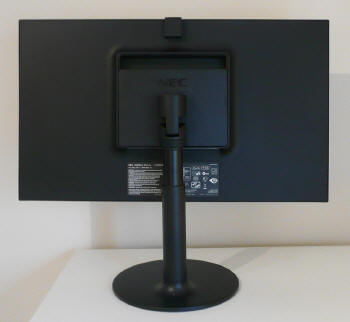
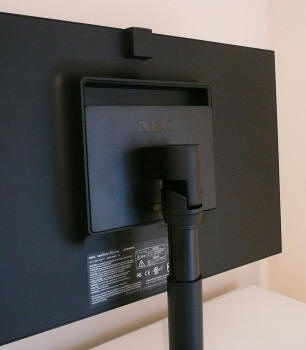
Above:
back views of the screen. Click for larger versions
The materials feel of a good quality on the
EX231Wp and the design looks sleek in my opinion. This is part of NEC's "Cool
Office" range and I think it would look nice in most environments. The
whole stand is quite thin as you can see. It has a rounded base and a thin,
but sturdy arm at the back. This stand offers a very good range of ergonomic
adjustments as well which is welcome. There is no noise detectable from the
screen at all and it gives off very little heat.
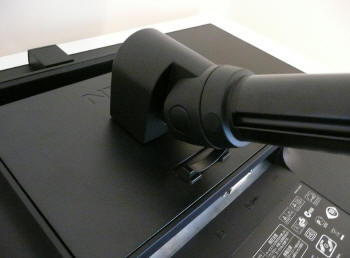
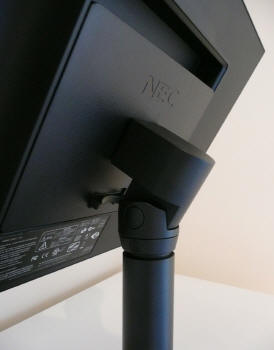
Above:
back views of the screen where the stand connects. Click for larger versions
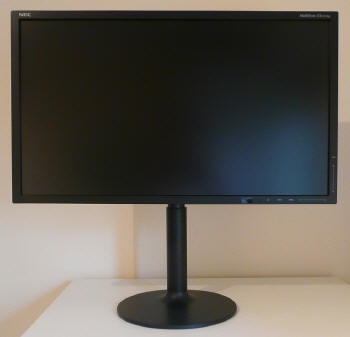
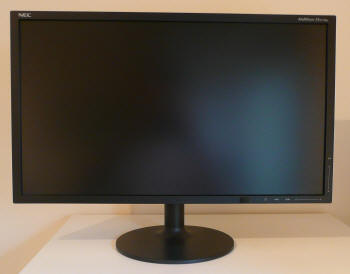
Above:
front views of the screen showing maximum and minimum height adjustments. Click for larger versions
The stand offers a height adjustment with a
range of 110mm. At the lowest setting the bottom of the lower bezel sits
approximately 90mm above the level of the desk. This can extend up to 200mm
when in maximum height mode. Movement of the height adjustments is smooth
although it is a little stiff initially when trying to manoeuvre the screen
downwards.
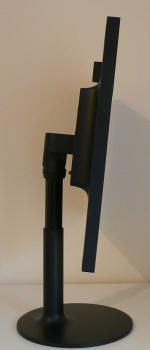
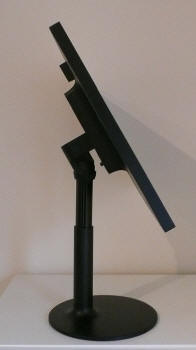
Above: Side
views of the screen showing maximum tilt range. Click for larger versions
The tilt range is also very good and is quite
smooth to manoeuvre. The operation is easy and it allows a very wide range of
adjustments which should allow you to obtain a comfortable position no matter
what your working conditions are. As you can also see from the above images,
the screen has a very thin profile thanks to its use of a W-LED backlighting
unit, and an external power supply. The screen comes packages with a small
external power brick and the necessary cable, and this has helped keep the
profile even thinner on this model. This would look particularly attractive
wall mounted as well, and the screen is VESA compliant.
There is a side to side swivel adjustment as
well whereby the base of the stand has a small rotating plate which sits on
the desk. This swivel range is very good side to side and is smooth and easy
to operate. There is a bit of a wobble to the screen back and forth if you
shake it though.
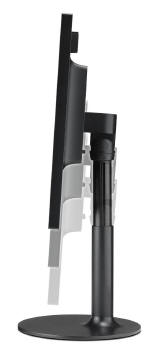
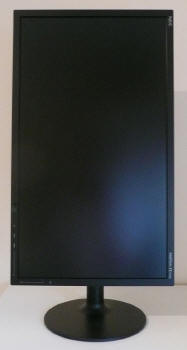
Above:
Height adjustment shown (left) and pivoted portrait mode (right). Click for
larger versions
The screen can also be rotated between landscape
and portrait modes as shown above. Being 16:9 aspect this does make the screen
feel very stretched when in this mode I think, but some users may find it
useful for some applications. This is fairly easy to use but a little stiff.
Thankfully the screen remains sturdy as you move it and there's no obvious
wobble on the desk from this adjustment.
A summary of the screens ergonomic adjustments
is shown below:
|
Function |
Range |
Smoothness |
Ease of Use |
|
Tilt |
Very good |
Quite Smooth |
Easy |
|
Height |
110mm |
Smooth |
Moderate |
|
Swivel |
Good |
Smooth |
Easy |
|
Rotate |
Full |
Quite Stiff |
Moderate |
|
Overall |
Good range of adjustments and mostly easy to
use. Stand a bit wobbly |

Above:
single USB 2.0 port on the top of the screen
The top of the screen features a single USB 2.0
port as shown above. This has a little plastic cover which must be lifted off
to use the connection port. I'm not sure about the positioning of this port to
be honest as I can only really see it being useful for connection of webcams,
where they would also clip onto the top of the screen. For anything else like
digital cameras, printers, keyboards etc the position is a bit odd, and would result
in a cable sticking unattractively out of the top of the screen and probably
getting in the way. Maybe it would have been better to include some additional
ports on the side for easy access and more logical positioning.

Above: OSD
touch sensitive operational buttons and sliders
The bottom right hand corner features all the
operational buttons. There is a small power LED which glows blue during normal
operation, and orange in standby mode. You can in fact control the brightness of this from within the OSD
menu if you want. There are no actual pressable buttons here, and instead all
of the controls are touch sensitive. You simply touch the bezel on the
relevant label to operate the menu and controls. This actually works very well
and the "buttons" are very responsive. There is quick access to selection of
inputs, and (if you enable the hot-key from within the menu) ECO modes. You
can also quick access the brightness control using the left/right arrow, and
contrast control by using the up/down arrow. We'll have a look at the
OSD menu in a moment.


Above:
Interface options available
The back of the screen features connections for
the power adapter, DisplayPort, DVI-I and USB (upstream). These are tucked
neatly underneath at the back of the screen where the stand connects.
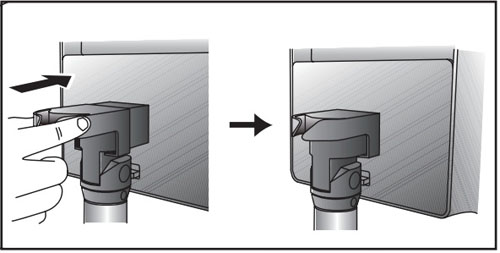
Above: how
to connect the provided cable tidy clip
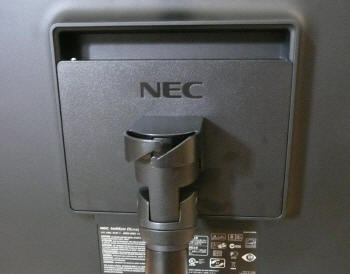
Above: back
of the screen with cable tidy attached. Click for larger version
The screen comes packaged with a plastic clip
which can be attached to the top of the stand as shown above, and acts as a
cable tidy. With the stands arm being so thin it can be a little tricky to get
the cables hidden properly however, even more so if you also have the power
brick holder attached as shown below.
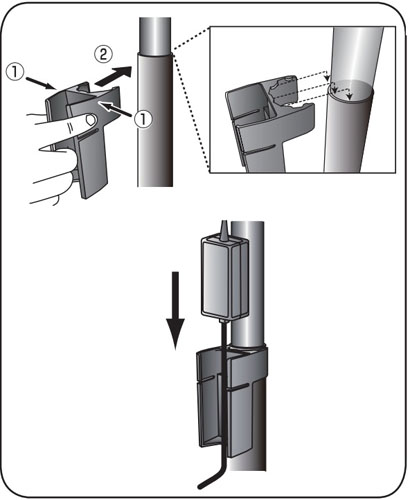
Above:
how to attach the provided power brick holder
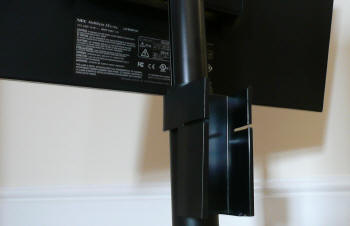
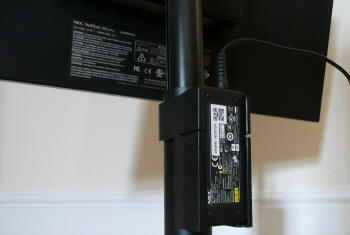
Above: back
of the stand with power brick holder attached. Click for larger versions
The screen is also packaged with a plastic
bracket which can be used to hold the external power brick. This clips on to
the back of the stand as shown and you simply slot in the power brick.

Removing the back of the EX231Wp confirms that
the screen is using Samsung's LTM230HP07 panel which we will discuss a little
later on. This is a new cPVA + W-LED module which we have not seen used
elsewhere yet.

OSD Menu
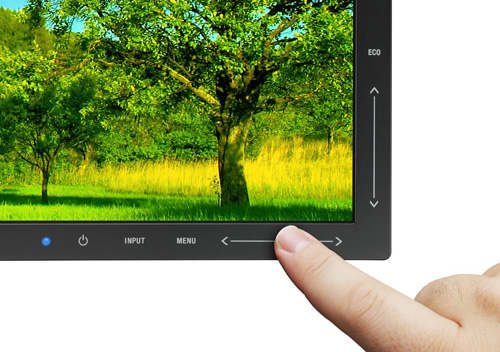
Unlike some of the other NEC screens we have
tested, the EX231Wp has touch sensitive OSD selection buttons. These are located
on the right hand side of the screen and work well. You only need to lightly
touch the bezel label to operate the command and some of them even act as touch
sensitive sliders. The arrows allow you to slide your finger along the bezel to
control the adjustments (of things like brightness) quickly and easily. This is
a nice touch and works well. A lighter tap to the arrows allows you to make the
finer adjustments.
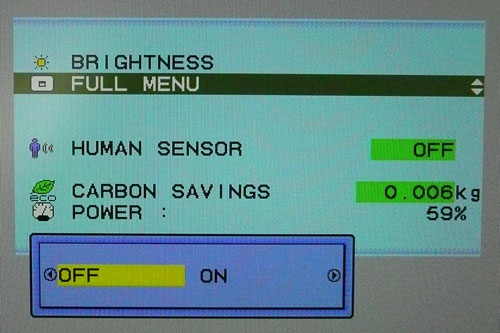
Pressing the menu 'button' brings up first of all
a simplified menu as shown above. There are only options for brightness control
and turning the human sensor on and off here. There is a carbon saving and power
meter shown as well to help you keep track of your carbon footprint. If you want access to the full set of options in the main menu you have
to select 'full menu' as 'on' as shown above.
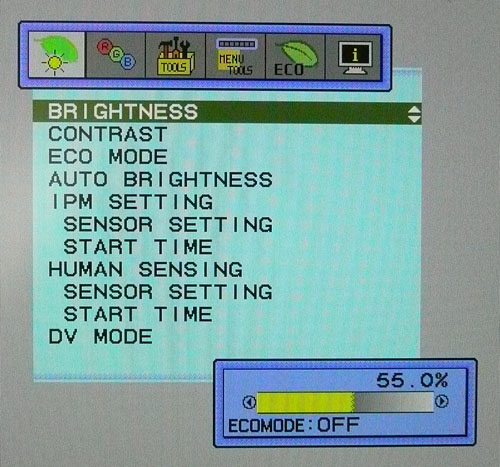
Once you enable the full menu there is a much
wider range of options. This is split into 6 sections along the top which you
can easily scroll through right and left. Moving down into a section allows you
to control the various options listed. In the first section you can control
things like brightness and contrast. These are in sliders with a % rating as
shown above. Various power conservation options are also available in this
section which we will talk about
in a moment. These include ECO mode, auto brightness, IPM setting and Human
sensing.
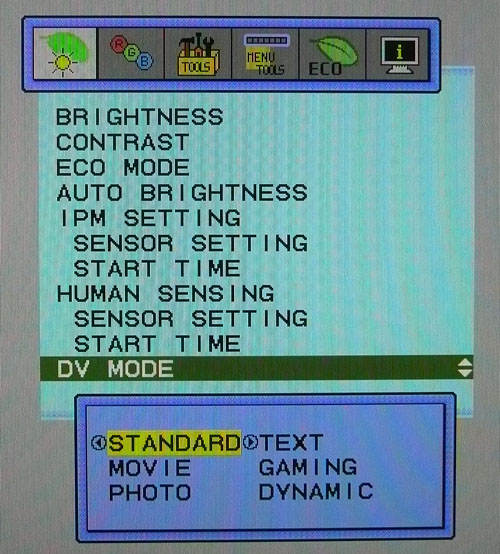
The bottom option is the DV mode setting which
offers you a range of 6 preset modes. These are standard, text, movie, gaming,
photo and dynamic. The last option turns on the
dynamic contrast ratio
which we will test later.
NOTE: When MOVIE, GAMING, or PHOTO is selected as the DV MODE, the NATIVE RGB
mode is
selected automatically as the six colour preset and cannot be changed.
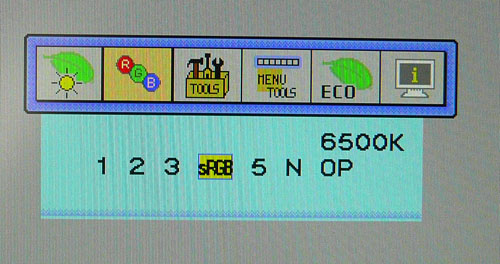
The RGB menu gives you access to 7 different
colour modes. These offer a range of preset colour temperatures (which
we will test later) along
with an sRGB mode (set to 6500k colour temperature), a 'native' mode of the LCD
panel and an 'option' setting which is designed to set the white point and gamma
curve near DICOM simulation. You can adjust the individual RGB channels in some
of these presets but not in sRGB, Native or Option as they are fixed modes.
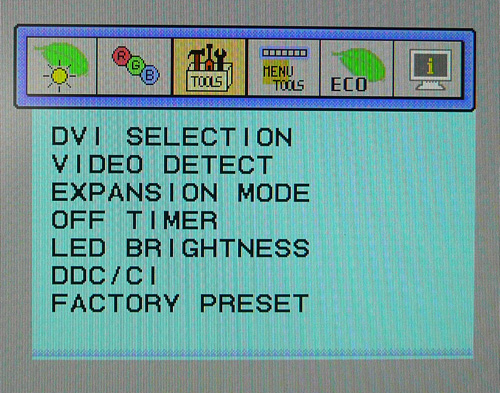
The tools menu gives you access to a few options
as shown above. The 'expansion mode' option allows you to control the screens
aspect ratio with options for 'full' (fill the screen regardless) or 'aspect'
(maintain the original source aspect ratio).
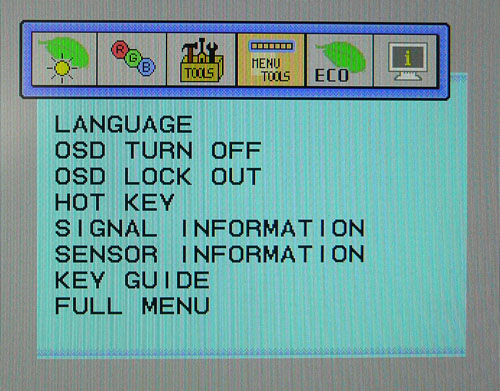
The menu tools section allows you to control
features relating to the OSD menu operation.
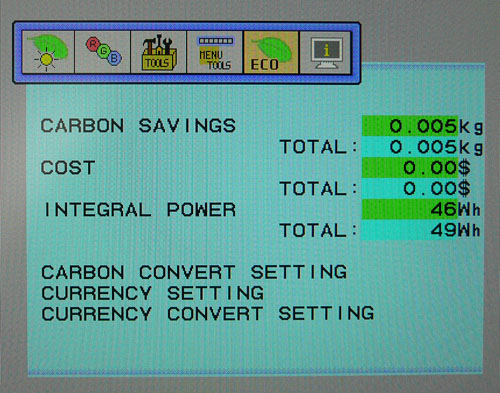
The ECO section gives you a series of measurements
showing your estimated carbon savings, cost and power usage.
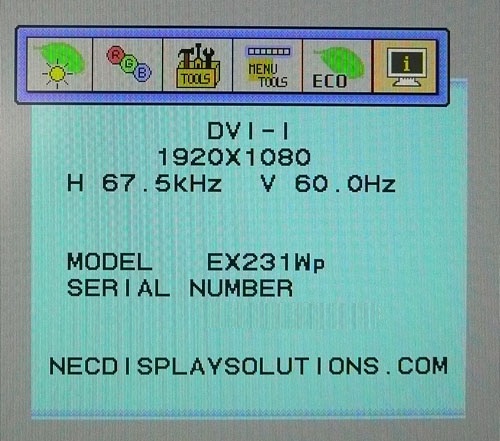
The last menu confirms the currently set
resolution and refresh rate along with your monitors serial number (removed in
the image
here). Overall the operation of the OSD menu is quite easy and pretty intuitive.
The touch sensitive buttons are easy to use and very responsive and there is a
good range of options overall to play with.

Power Consumption
The EX231Wp has various settings available which
help the user monitor and control their power consumption. Being based on a
W-LED backlighting unit, the screen is designed to be more eco friendly than
traditional CCFL backlit displays. There are various options available
including:
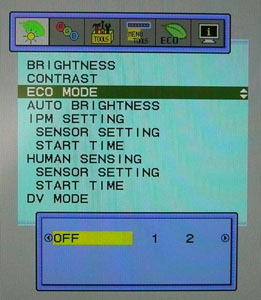
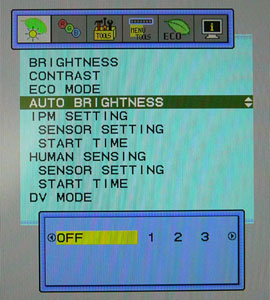
-
ECO Mode = There are three settings
available within the OSD menu including an 'off' setting.
-
ECO off allows you to control the screens
brightness setting as normal between 0 - 100%
-
ECO mode 1 restricts the brightness setting
available to between 0 - 80%. It therefore allows adjustments to be made in
which power is reduced to meet Energy Star measurement conditions according to
NEC.
-
ECO 2 restricts the brightness control further,
and it is only available between 0 and 40%. This allows adjustments to be made
in which power consumption is reduced by 30% compared to the maximum
brightness setting apparently
-
Auto Brightness = has 3 settings as
well as an 'off' setting:
-
(AUTO BRIGHTNESS) 1: Automatically adjusts the
brightness to the optimal setting by detecting the brightness
level of the users environment
-
(AUTO BRIGHTNESS) 2: Automatically adjusts the
brightness to the optimal brightness setting based on the white
display area. The environmental brightness sensor (AmbiBright sensor) has no
function.
-
(AUTO BRIGHTNESS) 3: Automatically adjusts the
brightness to the optimal setting based on the white display area
and by using the AmbiBright sensor to detect the brightness level of the
environment
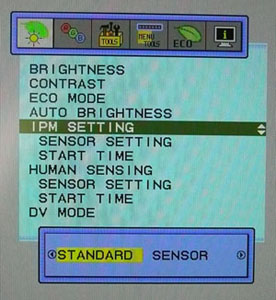
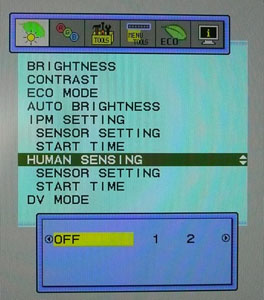
-
Intelligent Power Manager (IPM) = The
Intelligent Power Manager allows the monitor to enter into power saving mode
after a period of inactivity. The IPM has two settings:
-
STANDARD: Monitor enters into power saving mode
automatically when the input signal is lost.
-
SENSOR: Monitor enters into power saving mode
automatically when the amount of surrounding light goes below the level
determined by you. The level can be adjusted in IPM sensor setting as can the
time it waits before kicking in to action.
When in power saving mode, the LED on the front of the monitor becomes dark
blue. When in power saving mode, touch any of the front Keys, except for POWER
and INPUT, to return to normal. When the amount of surrounding light returns to
normal levels, the monitor will automatically return to normal mode
-
Human Sensing = The sensor on the front
side of the monitor detects the movement of a person by using the HUMAN SENSING
function. THE HUMAN SENSING has three settings:
-
OFF: No human sensing.
-
(HUMAN SENSING)1: After it is detected that there
is no person after a period of time, the monitor shifts to low brightness mode
automatically to reduce the power consumption. When a person comes near the
monitor again, the monitor will automatically return to normal mode. START TIME
adjusts wait time to react to doing.
-
(HUMAN SENSING)2: After it is detected that there
is no person, the monitor shifts to power saving mode automatically to reduce
the power consumption. When a person comes near the monitor again, it comes back
from the power saving mode and displays the images.

The ECO section of the OSD menu gives you various
readings and estimates based on your power consumption. These are:
-
CARBON SAVINGS: Displays the estimated carbon
savings information in kg.
-
COST: Displays the electricity cost savings in balance.
-
INTEGRAL POWER: Displays multiple values of the power consumption.
-
CARBON CONVERT SETTING: Adjusts the carbon footprint factor in the carbon saving
calculation. This initial
setting is based on the OECD (2008 Edition).
-
CURRENCY SETTING: Displays electricity pricing in 6 currency units.
-
CURRENCY CONVERT SETTING: Displays electricity savings in kW/hour (US Currency
is default).
In terms of power consumption the manufacturers spec states
normal operation
usage of 23W at default settings, and 31W maximum. They do not list a standby
power consumption in their spec.
|
 |
|
State and Brightness
Setting |
Power Usage
(W) |
|
Factory Default |
21.6 |
|
ECO mode / Auto-brightness = Off |
24.1 |
|
Calibrated (55%) |
17.7 |
|
Maximum Brightness (100%) |
25.3 |
|
Minimum Brightness (0%) |
8.9 |
|
Standby |
0.6 |
|
We tested this ourselves and found that out of the
box the screen used 21.6W of power, just slightly lower than the specified 23W.
Maximum brightness used 25.3W of power so the additional draw to reach the
manufacturers 31W must be when also powering a USB device from the included
port.
By default the screen is in ECO mode 1 which
gives you a brightness setting of 80%, and auto-brightness level 1 is selected.
Turning ECO mode and auto-brightness off reverts the screen to 95% brightness
setting which uses 24.1W of power. After calibration, where we had adjusted the
brightness control to 55% and therefore the backlight intensity, this was
reduced to 17.7W. In standby the screen uses only 0.6W of power. This was very
comparable of course to the other W-LED backlit models we have tested when you
compare calibrated and standby power consumptions. I have plotted the results of
these measurements on the graph below:



Colour Accuracy, Black
Depth and Contrast
The Panel and Backlighting Unit
The NEC EX231Wp utilises a Samsung
LTM230HP07
cPVA panel which is
capable of producing 16.7 million colours. We have not been able to review the
detailed panel specification document for this particular module to verify
whether it is a true 8-bit panel, of whether it is using 6-bit + A-FRC to
produce the 16.7 million colours. Certainly the previous cPVA panels like the
HP01 used 6-bit + AFRC colour depth. This is different to some other true 8-bit
PVA/S-PVA matrices, but this is a measure taken to achieve a lower price point
for these modern lower-cost displays. Studying gradients and darker tone
rendering of the panel does seem to suggest it is using FRC but this is not
something you'd ever notice in practice and if it is being used, it is very well
implemented.
The EX231Wp uses
White-LED (W-LED) backlighting. The colour space of this screen is
approximately equal to the sRGB reference and is considered a 'standard gamut'
backlight type. Again, without being able to study the full panel spec sheet we
cannot confirm the exact % coverage of the sRGB, NTSC or Adobe RGB colour space,
but it is for all intents and purposes a standard gamut backlight unit.
Testing Methodology
An
important thing to consider for most users is how a screen will perform out of
the box and with some basic manual adjustments. Since most users won't have
access to hardware colorimeter tools, it is important to understand how the
screen is going to perform in terms of colour accuracy for the average user.
I
restored my graphics card to default settings and disabled any previously active
ICC profiles and gamma corrections. The screen was tested at default factory settings using the DVI interface, and analysed using
an
X-rite i1 Pro spectrophotometer combined with
LaCie's Blue Eye Pro software suite. An NEC branded and customised X-rite i1 Display 2 colorimeter was
also used to verify the black point and contrast ratio since the i1 Pro is less
reliable at the darker end.
Targets for these tests are as follows:
-
CIE Diagram - validates the colour space
covered by the monitors backlighting with the black triangle representing the
display
-
Gamma - we aim for 2.2 which is the default
for computer monitors
-
Colour temperature / white point - we aim
for 6500k which is the temperature of daylight
-
Luminance - we aim for 120
cd/m2, which is
the recommended luminance for LCD monitors in normal lighting conditions
-
Black depth - we aim
for as low as possible to maximise shadow detail and to offer us the best
contrast ratio
-
Contrast ratio - we aim
for as high as possible. Any dynamic contrast ratio controls are turned off here
if present
-
dE average / maximum -
as low as possible.
If DeltaE >3, the color displayed is significantly different from the
theoretical one, meaning that the difference will be perceptible to the
viewer.
If DeltaE <2, LaCie considers the calibration a success; there remains a
slight difference, but it is barely undetectable.
If DeltaE < 1, the color fidelity is excellent.

Default settings of the screen were as below. Note that the only option disabled
here was the auto-brightness control as I did not want that adjusting the
brightness level during testing:
|
Monitor OSD Option |
Default Settings |
|
Brightness |
80% |
|
Contrast |
50% |
|
RGB Setting |
Native |
|
ECO Mode |
1 |
|
Auto Brightness |
Off |

NEC EX231Wp - Default Factory Settings


|
|
Default Settings |
|
luminance (cd/m2) |
224.9 |
|
Black Point (cd/m2) |
0.06 |
|
Contrast Ratio |
3753:1 |
The out of the box performance of the EX231Wp was
moderate but not great. The
CIE diagram on the left confirms that the monitors colour gamut (black
triangle) is reasonably close to matching the sRGB colour space (orange
triangle). It extends a little past the sRGB space along two of the edges in
this 2D view of gamut which is a little more than most W-LED backlighting units
achieve in fact. It doesn't quite cover all the green shades however.

Default gamma was recorded at 2.1 average, leaving it
2%
out from the target of 2.2. Gamma was actually close to the target
2.2 in
the darkest and medium greys but deviated as low as 2.05 in other shades. White
point was a little out here at 6081k which was 6% out from the target. Note that
we are using a Spectrophotometer to make these measurements which is not
sensitive to the W-LED backlight as some colorimeter devices can be. When using
a colorimeter with a W-LED backlit screen there can be a typical deviance of 300
- 600k in the white point measurement which is why some sources may refer to a
lower white point in this test incorrectly.
Luminance was recorded at a high 224.9
cd/m2 which is
too high for comfortable use. The OSD is set at 80% brightness and this is still
too much. Even at this high 224.9 cd/m2 luminance, the black depth
was an incredible 0.06 cd/m2. This gave us a static contrast ratio of
3753:1 which is amazing and another great showing from the latest generations of
PVA technology.
Colour accuracy was mediocre at default factory
settings with an average DeltaE (dE) of 3.0, ranging up to a maximum of 8.3. The screen
felt quite even to the naked eye with some slight tendency towards green. It was overly bright at these default
settings as well. Some minor OSD adjustments to the brightness can hopefully help
improve the default set up for casual users who don't have access to a hardware
calibration device.

I also wanted to test the screen at the same
settings, but after switching to the 'sRGB / 6500k' colour mode. All other
settings were left as they were.
|
Monitor OSD Option |
Settings |
|
Brightness |
80% |
|
Contrast |
50% |
|
RGB Setting |
sRGB 6500k |
|
ECO Mode |
1 |
|
Auto Brightness |
Off |

NEC EX231Wp - Default Factory Settings, sRGB Preset
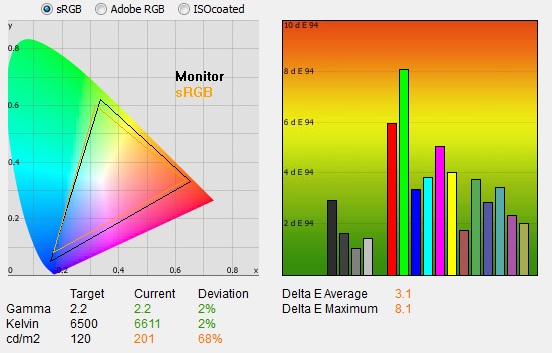
|
|
Default Settings,
sRGB preset |
|
luminance (cd/m2) |
201 |
|
Black Point (cd/m2) |
0.06 |
|
Contrast Ratio |
3364:1 |
According to the EX231Wp manual: "sRGB mode
dramatically improves the colour fidelity in the desktop environment by a single
standard RGB colour space. With this colour supported environment, the operator
could easily and confidently communicate colour without further colour
management overhead in the most common situations."
The only real difference when switching to this
sRGB preset mode was that the white point was now much closer to the target of
6500k. We recorded this as 6611k, being now only 2% out from the target. There
is no emulation of a slightly reduced colour space or anything to bring it more
in line with the sRGB reference and the gamut coverage remains the same as the
'native' mode.

It seems this defined colour temperature preset
was quite reliable. Gamma remained at a similar deviance as before (2%)
but luminance was lowered a little to 201
cd/m2. The
static contrast ratio was still excellent at 3364:1, and the slight drop can be
attributed to rounding errors of the low blank point as opposed to anything
else. Colour accuracy remains pretty much the same with average dE of 3.1. The
only real difference is the improved white point in this mode, so it would be a
good change to make if you are aiming to achieve that colour temperature for
your uses. This would also likely be a good starting point before any
calibration or profiling of the screen along with a reduction in the brightness
control to something more comfortable.

Testing Colour Temperatures
The EX231Wp features a range of colour temperature
preset modes which we wanted to test to establish how accurate they were. We
measured the colour temperature of the screen with the X-rite i1 Pro
spectrophotometer. All other settings were left at factory defaults and no ICC
profile was active. The results are recorded below:
|
Selected
Preset Mode |
Measured Colour Temperature |
Deviance |
|
1 - 9300k |
9771k |
471k |
|
2 - 8200k |
8562k |
362k |
|
3 - 7500k |
7811k |
311k |
|
sRGB - 6500k |
6736k |
236k |
|
5 - 5000k |
5338k |
338k |
|
N - Native |
6199k |
- |
|
OP - Option |
8056k |
- |
As you can see there is a small difference
between the preset and the measured colour temperature in each of these
models. This is about 471k out in the coolest 9300k mode, but is a bit closer
as you move into the warmer modes. In fact the sRGB mode was closest to the
desired value at only 236k deviance.

Calibration Results

I wanted to calibrate and profile the screen to determine what was possible with optimum settings and
profiling. I used the
X-rite i1 Pro spectrophotometer
combined with the LaCie Blue Eye Pro software package to achieve these results
and reports. An NEC branded and customised X-rite i1 Display 2 was used to
validate the black depth and contrast ratios due to lower end limitations of the
i1 Pro device.

Dell U2412M - Calibrated Settings, Standard Mode
|
Monitor OSD Option |
Adjusted Setting |
|
Brightness |
55% |
|
Contrast |
50% |
|
RGB Setting |
sRGB 6500k |
|
ECO Mode |
Off |
|
Auto Brightness |
Off |
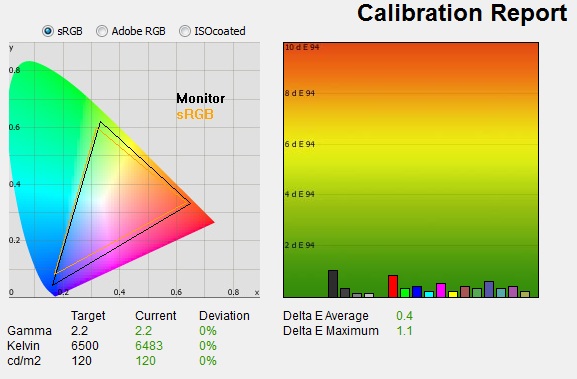
|
|
Calibrated Settings |
|
luminance (cd/m2) |
120 |
|
Black Point (cd/m2) |
0.04 |
|
Contrast Ratio |
3075:1 |
I first of all switched to the sRGB preset mode
since this had returned a white point closest to our target of 6500k. This preset does not allow you to adjust the individual RGB
channels so the only hardware adjustments I would be making potentially are to
the brightness and contrast levels. I
followed LaCie's calibration process through, adjusting the OSD brightness setting in line
with the recommendations made in the process, and then letting the software
carry out the LUT adjustments at a graphics card level and create an
ICC profile. The screen does not feature a hardware LUT calibration option
so other than the OSD alterations, the rest of the process is carried out at a
graphics card level in profiling the screen.

The calibration was a great success. The gamma
discrepancy that we saw before in this mode (2%) had been
corrected now to leave us with 0% deviance from the target of 2.2 and white point was basically spot on at 6483k
correcting the small 2% deviance from default settings.
Luminance had been reduced to a more comfortable 120
cd/m2 after the
adjustment of the OSD brightness control to 55%. Black depth was still amazing
0.04 cd/m2 and this gave us an excellent calibrated static contrast
ratio of 3075:1. Again some of this reduction compared with the out of the box
measurements may well be accounted for in rounding of the numbers but there will
be a slight drop in actual contrast ratio due to the other corrections being
made here at a software level.
Colour accuracy was also improved nicely with dE average now
only 0.4
and maximum only 1.1. LaCie would consider colour fidelity to be excellent. Testing the screen with various colour gradients
showed smooth transitions with no sign of any obvious colour banding. There was
some gradation evident in darker tones but overall no issues, and nothing
that you don't see on most screens.
You can use our settings and
try our calibrated ICC profile if you wish, which are available in
our ICC profile database.

Calibration
Performance Comparisons
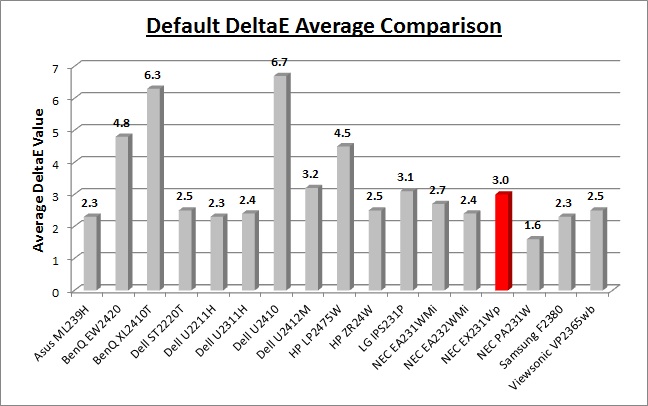
I've provided a comparison above of the EX231Wp
against some of the other screens we have tested in a similar size range. Out of
the box average dE was 3.0 on the EX231Wp which was mediocre. It was better than the
BenQ EW2420. That model used one of AU
Optronics' AMVA panels with W-LED backlighting and was worse at 4.8.
The default colour accuracy of the EX231Wp was comparable, although not quite
as good, as some of the
23"
IPS models we have tested including the
Dell U2311H (2.4),
NEC EA231WMi (2.7) and
ViewSonic VP2365wb (2.5). Even though the EX231Wp was a little higher at
3.0 this is a minimal difference really out of the box.
Some of the 23" IPS + W-LED
screens we have tested are also quite similar such as the
NEC EA232WMi (2.4),
LG IPS231P (3.1) and the
Asus ML239H (2.3). The professional grade 23"
NEC PA231W was better still at 1.3 dE average. So the EX231Wp was not quite
as accurate out of the box as these IPS based models.
Compared with the
Samsung F2380 it was also a little behind. That model uses a cPVA panel as
well but was a bit more accurate with average dE of 2.3 out of the box. A
moderate performance in
terms of default colour accuracy from the EX231Wp and a little behind
the competition really. Some form of software profiling using a colorimeter
would of course be beneficial to correct some of the colours.
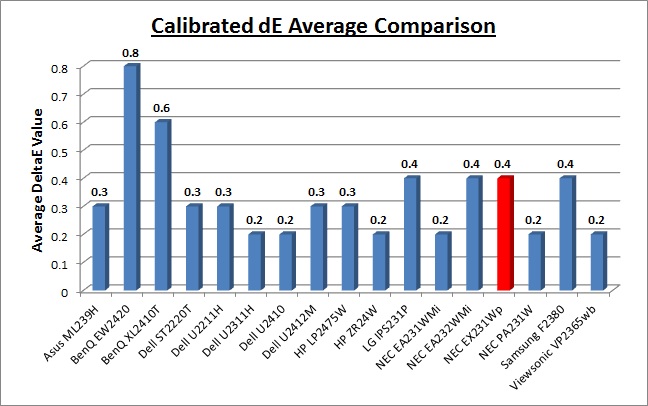
Once calibrated the dE average was reduced to 0.4.
This would be classified as excellent colour fidelity by LaCie. It was not quite
as low as some of the other screens here which reached down to 0.2 average, but
in practice you would not notice any difference here. Some of the
professional range models from NEC are even more accurate. Professional grade
monitors like the NEC PA series also offer other high end features which
separate them from some of these other models, including extended internal
processing, 3D LUT's and hardware calibration. These comparisons are based on a
small selection of tests, so it should be remembered that other factors do come
into play when you start talking about professional use. For further information
and tests of a high end professional grade screen with hardware LUT calibration,
you may want to have a read of our
NEC SpectraView Reference 271 review.
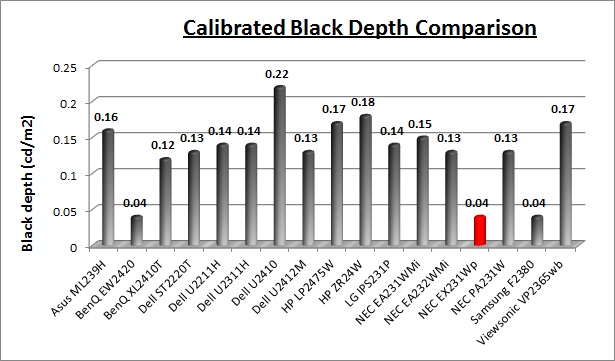
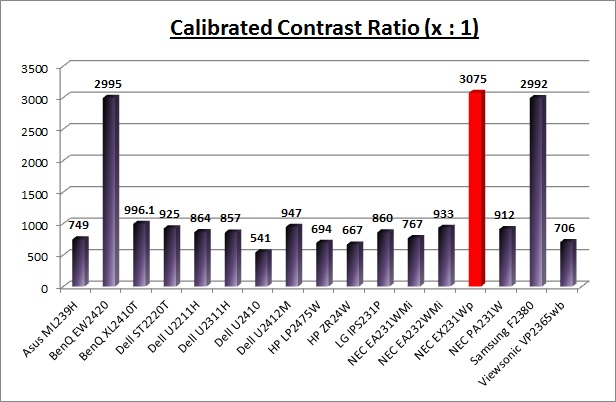
The black depth and contrast ratio of the EX231Wp
were incredible, and something we had seen before from the Samsung F2380 (cPVA)
and BenQ EW2420 (AMVA). The black depth was a very low 0.04 after calibration
and static contrast ratio was 3075:1. There could well be some rounding errors
in this even so I would just say that the static CR is >3000:1 on this model
even after calibration and profiling.

Contrast
Stability
I wanted to see how much variance there was in the screens contrast as we
adjusted the monitor setting for brightness.
In theory, brightness and contrast are two independent parameters, and good
contrast is a requirement regardless of the brightness adjustment.
Unfortunately, such is not always the case in practice. We recorded the
screens luminance and black depth at various OSD brightness settings, and
calculated the contrast ratio from there. Graphics card settings were left at
default with no ICC profile or calibration active. Tests were made using an
NEC branded and customised
X-rite i1 Display 2 colorimeter. It should be noted that we used the
BasICColor calibration software here to record these, and so luminance at
default settings may vary a little from the LaCie Blue Eye Pro report.
Note: We disabled ECO mode
and auto-brightness from the OSD menu which are active out of the box.
|
OSD Brightness |
Luminance
(cd/m2) |
Black Point (cd/m2) |
Contrast Ratio
( x:1) |
|
100 |
279.6 |
0.08 |
3495 |
|
90 |
252.8 |
0.07 |
3611 |
|
80 |
226.4 |
0.06 |
3773 |
|
70 |
199.7 |
0.05 |
3995 |
|
60 |
173.0 |
0.04 |
4324 |
|
50 |
145.9 |
0.04 |
3646 |
|
40 |
118.4 |
0.03 |
3946 |
|
30 |
90.8 |
0.02 |
4538 |
|
20 |
63.0 |
<0.02 |
- |
|
10 |
34.8 |
<0.02 |
- |
|
0 |
6.3 |
<0.02 |
- |
|
Luminance Adjustment Range = 273.3 cd/m2
Black
Point Adjustment Range = >0.06 cd/m2
Average
Contrast Ratio = 3916:1
|
The luminance range of the screen was very
impressive indeed and the brightness control allowed you to vary the W-LED
backlight intensity from 279.6
cd/m2 at
maximum 100%, all the way down to an extremely low 6.3 cd/m2 at 0%. In fact
the maximum brightness was a little above even the quoted maximum brightness
spec of the screen (250). There was 273.3 cd/m2 worth of adjustment range
available here which should easily allow you to obtain a comfortable setting for
your working environment. Even those who prefer very low luminance settings
should be fine here with the lower range available. A setting of around 40% should offer you a luminance of ~120 cd/m2
out of the box.
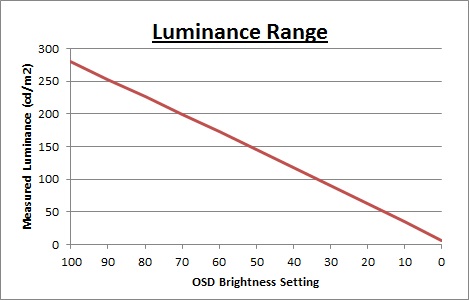
We have plotted the luminance trend on the
graph above. The screen behaves as it should, with a reduction in the backlight
intensity controlled by the reduction in the OSD brightness setting.
Black depth was very impressive across the
whole range, being between 0.08 and 0.02
cd/m2.
In fact at the lowest end the reading was even less than 0.02
cd/m2
but that is the limit of the
NEC i1 Display 2 colorimeter unfortunately. Contrast remained stable across the
range. In fact most of the variation can probably be accounted for in rounding
of the numbers, particular black point which is so low across the board and does
not change massively at two decimal places. A static contrast ratio of >3000:1
is incredible and easily achieved here. In fact out of the box the average CR
measurement was 3916:1.
I will not publish the usual contrast
stability graph as it is not an accurate view due to rounding errors.

Dynamic Contrast
|
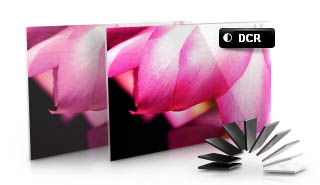 |
The NEC EX231Wp features a dynamic contrast ratio
(DCR) control, which boasts a spec of 25,000:1.
Dynamic contrast ratio involves controlling the
backlight of the screen automatically, depending on the content shown on the
screen. In bright images, the backlight is increased, and in darker images, it
is decreased. For this test I would use the colorimeter to record the
luminance and black depths at the two extremes. Max brightness would be
recorded on an all white screen once the DCR has caught up. Black depth would
be recorded on an all black screen. |
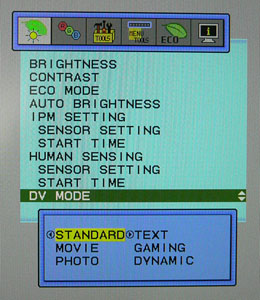
The DCR feature is only available when you
select 'dynamic' from the DV mode menu. The brightness control remains active
in the OSD menu and is not greyed out as it is on some screens. This
fluctuates as the DCR function operates as the feature is in fact just
controlling the brightness setting. You cannot turn ECO mode or Auto
brightness on when in DV dynamic mode. There is no option to turn the DCR on
or off, it is just enabled all the time in this 'dynamic' DV mode.
|
|
Dynamic Contrast |
|
Specified DCR Range |
25,000 : 1 |
|
Available in Presets |
Dynamic DV mode |
|
Settings |
n/a |
|
Max luminance (cd/m2) |
143.4 |
|
Min Black Point (cd/m2) |
<0.02 |
|
Max Dynamic Contrast Ratio |
>7169:1 |
The tests that we carry out to measure dynamic
contrast ratio involve an almost completely white and almost completely black
screen. In real use you are very unlikely to ever see a full black or full white
screen, and even our tests are an extreme case to be honest. Carrying out the tests in this
way does give you a good indication of the screens dynamic contrast ratio in
real life situations however.
Carrying out this test showed the feature worked
quite well. The transitions were fairly smooth although quite slow to take
place. When switching between an almost all white screen and an almost all black
screen you can spot from the OSD menu that the brightness control is being
changed between 9% and 65%. This returns us a high DCR ratio of more than 7169:1.
In fact we could not accurately measure the black point as it reached below the
0.02
cd/m2
limitation of the i1 Display 2 colorimeter we were using. So the DCR function
does seem to trend towards the 25,000:1 spec which is pleasing. A dynamic
contrast which works for once!

Viewing Angles

Above: Viewing
angles shown from front and side, and from above and below. Click for
larger image
Viewing angles of the EX231Wp were pretty much in
keeping with other VA based panels. From a horizontal perspective there was a
pale tinge introduced from even quite low angles and in fact this was more
noticeable than on the other cPVA panel we tested in the Samsung F2380. From a
wider angle still there was of course a more apparent contrast shift but this is
to be expected. Vertically there was a more
obvious contrast shift detectable with a movement up or down where the image
became lighter and washed out. There was also a yellow tinge to the
image from above and below as you can see from the above pictures. The angles were certainly better than TN Film
matrices vertically, and free of the obvious vertical darkening you see from TN Film
technology but they were not as good as IPS panel technology. They did also seem
to be more restrictive, with a more noticeable gamma and contrast shift, than
the cPVA panel used in the
Samsung F2380 when we tested that. As a reminder this is a newer cPVA module
and so pixel structure and performance appears to have been altered.
There was an off-centre contrast shift which is
inherent to VA panel types noticeable here as well. Using a test image which
shows a dark grey font on a black background you can easily test this 'feature'.
From head on, the text was still visible but was certainly darker than if you
viewed it from a side angle. This is down to the pixel alignment in a PVA
matrix. It was not as severe as on the Samsung F2380 though where the text was
invisible from head on, and could only be seen from a wide angle of about 45°.
It seems that although the normal viewing angles are not as good on this newer
cPVA panel, the off-centre gamma shift issue has been improved somewhat which is
a pleasant surprise.
This off centre gamma shift test is an extreme case of course as this is a
very dark grey tone we are testing with. Lighter greys and other colours will
appear a little darker from head on than they will from a side angle, but you
may well find you lose some detail as a result. This can be particularly
problematic in dark images and where grey tone is important. It is this issue
that has led to many graphics professionals and colour enthusiasts choosing IPS
panels instead, and the manufacturers have been quick to incorporate this
alternative panel technology in their screens. I would like to make a point that
for many people this won't be an issue at all, and many may not even notice it.
Remember, many people are perfectly happy with their TN Film panels and other VA
based screens. Just something to be wary of if you are affected by this issue or
are doing colour critical work.

Panel Uniformity
Measurements of the screens luminance were taken
at 35 points across the panel on a pure white background. The measurements were
taken using BasICColor's calibration software package, combined with the NEC
customised X-rite
i1 Display 2 colorimeter. The above uniformity diagram shows the difference, as
a percentage, between the luminance recorded at each point on the screen, as
compared with the reference point of a calibrated central point at 120 cd/m2. This is
the desired level of luminance for an LCD screen in normal lighting conditions,
and the below shows the variance in the luminance across the screen
compared with this point. It is worth noting that panel uniformity can vary from
one screen to another, and can depend on manufacturing lines, screen transport
and other local factors. This is only a guide of the uniformity of the sample
screen we have for review.
Uniformity of Luminance
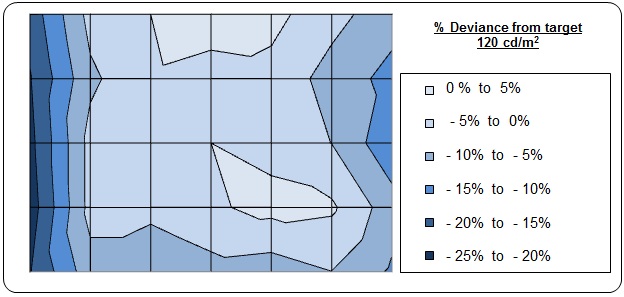
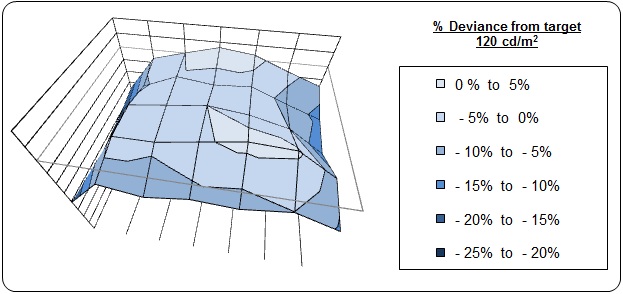
The luminance uniformity of the EX231WP sample was
mostly good. The maximum deviations from the central measurement of 120
cd/m2 were as low as 97 cd/m2
along the left hand edge. The right hand edge also showed a slightly darker
area, reaching down to around 105 cd/m2. 77% of the screen
remained within 10% deviance of the target luminance which was good and it
was really this left hand edge which dropped off considerably in the
measurements. This was not however obvious under normal use and even viewing
full white and grey backgrounds in a darkened room did not present any
obvious changes across the screen to the naked eye.
Backlight Leakage
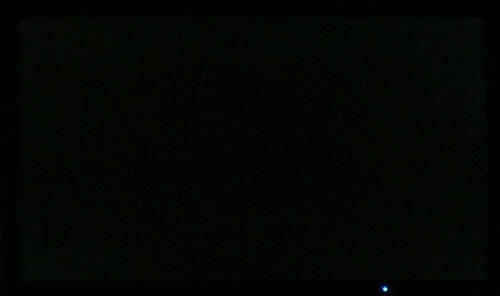
Above: All black screen in a darkened room. Click for larger version
As usual we also tested the screen with an all
black image and in a darkened room. A camera was used to capture the result.
Overall the appearance of an all black screen was very good in this test. You
will see that the blacks are very black here as the cPVA panel offers some
brilliant black levels and a very high static contrast ratio. There was no
noticeable backlight leakage from any of the corners or edges which was
pleasing.

General and Office Applications
The 23" screen size and high 1920 x 1080
resolution were very pleasant for office working, and although you do lose a bit
of height vertically compared with a 1920 x 1200 screen, it was nothing too bad.
Image quality was very crisp and sharp using the DVI interface. The 0.265 mm
pixel pitch was slightly smaller than a 23.6" 1920 x 1080 screen of course
(0.2715 mm) and 24" 1920 x 1080 screen (0.276 mm), but text size felt about
right for every day use.
Default luminance of the screen was too high for
prolonged office use at 225
cd/m2,
although this was with the screen set at 80% brightness. For comfortable use in
normal lighting conditions a setting of around 40 - 50% should return you a
luminance of ~120
cd/m2. There was a specific 'text'
preset mode available from within the DV mode menu and it made the image a
little darker than the standard mode (note: brightness control was not changed
however).
The ergonomics of
the screen offered a good wide range of adjustments. It was good to see a full
range of height, tilt, pivot and swivel available and they were all pretty easy
and smooth to use. You should be able to position the screen at a comfortable
setting for your individual preferences. It was a bit of a shame not to see some
more USB ports available although at least there was one available from the top
of the screen which might be useful for connecting webcams and the like. There
was also a few extra features which are useful for power saving including an
ambient light sensor with automatic brightness control (AmbiBright feature), a
human sensor and various power management tools which we discussed
earlier in the review.

Above: photo of
text at 1920 x 1080 (top) and 1680 x 1050 (bottom)
The screen is designed to run at its native
resolution of 1920 x 1080 and at a 60Hz recommended refresh rate. However, if
you want you are able to run the screen outside of this resolution. We tested
the screen at a lower 1680 x 1050 resolution to see how the screen handles the
interpolation of the resolution. At native resolution the text was sharp as
you can see from the top photograph. When you switch to a lower resolution the
text is more blurry, and there is some overlapping of the text across the
pixels. Native resolution is recommended where possible although lower
resolutions are not too severe and the resolution is handled quite well.

Responsiveness and Gaming
The screen was tested again using the chase test
in PixPerAn for the display comparisons. As a reminder, a series of pictures
are taken on the highest shutter speed and compared, with the best case example
shown on the left, and worst case example on the right. This should
only be used as a rough guide to comparative responsiveness but is handy for a
direct comparison of the impact of this setting:

23" 25ms
Samsung cPVA (W-LED)

23"
5ms G2G LG.Display e-IPS (W-LED)

23"
14ms LG.Display e-IPS (W-LED)

23"
5ms G2G LG.Display e-IPS (W-LED) - Trace Free setting 40

24" 8ms G2G
LG.Display e-IPS (W-LED)
The EX231Wp is rated by NEC as having an 25ms (typ) response time which implies
that the panel is not using any form of
overdrive /
response time compensation (RTC) technology. This is normally used to boost pixel
transitions across grey to grey changes but without it, the panel is quoted
using the ISO black > white > black transition which is recorded at 25ms. Have a read about response time in
our
specs section if any of this is new to you.
As you can see, without RTC being used on this
screen the responsiveness of the panel is not very good. There is an obvious
motion blur detectable on moving images and this is picked up in our tests well.
There is an obvious ghost image behind the moving car even in the best case
photos. It is in fact a little slower than the LG IPS231P and NEC EA232WMi which
both use an IPS panel, again without any form of RTC being applied (note: the LG
IPS231P spec suggests RTC is being used to give it a 5ms G2G response time but
in practice it appears it does not use RTC and should be rated as a 14ms ISO
response time like the EA232WMi). These non-overdriven IPS panels are a little
faster than a modern cPVA panel when RTC is not used.
If you also compare the results of the EX231Wp
against the Asus ML239H and Dell U2412M you will see the improvement made when
RTC is applied to boost response times. This is noticeable in practice offering
much smoother movement and less motion blur. Of course on the plus side, without
RTC being used on the EX231Wp there is no 'overshoot' caused where dark or pale
halos can sometimes appear. For example the Dell U2412M shows some slight dark
overshoot in the above images.

23" 25ms
Samsung cPVA (W-LED)

23"
8ms G2G Samsung cPVA (Response Time setting = Fastest)

24"
8ms G2G AU Optronics AMVA (W-LED)
The above also compares the EX231Wp with a couple
of similar VA based models. The Samsung F2380 used a slightly older cPVA panel
but did have an RTC impulse applied to boost responsiveness. It wasn't super
fast, but there is a marked improvement compared with this non-overdrive NEC
model. The BenQ EW2420 uses an AU Optronics AMVA panel and although there was
some RTC applied it was still a fairly slow panel in practice and performs quite
similarly to the EX231Wp.

23" 25ms
Samsung cPVA (W-LED)

23"
8ms G2G LG.Display e-IPS

24" 6ms
G2G LG.Display H-IPS

21.5"
8ms G2G LG.Display e-IPS

24" 5ms G2G LG.Display e-IPS
I have also provided a comparison against several
popular CCFL backlit models. You will see that all of these models are more
responsive in practice thanks to their overdriven IPS panels.

23" 25ms
Samsung cPVA (W-LED)

23.6" 2ms G2G CMO TN Film (120Hz)

22" 3ms G2G Samsung TN Film + 120Hz
I've also included a comparison above against two
gamer-orientated screens, both featuring heavily overdriven TN Film panels, and
120Hz technology. The pixel responsiveness of both of these is ahead
of the EX231Wp, and the 120Hz frequency allows for
improved 120fps frame rates and the support of 3D content as well. The BenQ
XL2410T does show some even more obvious RTC overshoot in the form of very dark
trails behind the moving image (speech bubble and head) which is unfortunate,
and a sign that the RTC impulse is too aggressive. The Samsung 2233RZ remains
our champion in this test.
The responsiveness of the EX231Wp is not really that great sadly. There is no
RTC applied and so there is a pretty large amount of motion blur detectable and
the tests show that it cannot compete with the other popular models in the
23-24" size range. It should suffice for some light gaming, as after all this
isn't really a screen aimed at the gamers market anyway. Any FPS games or more
serious fast paced action would be more suited on one of the other models
though.
Additional Gaming Features
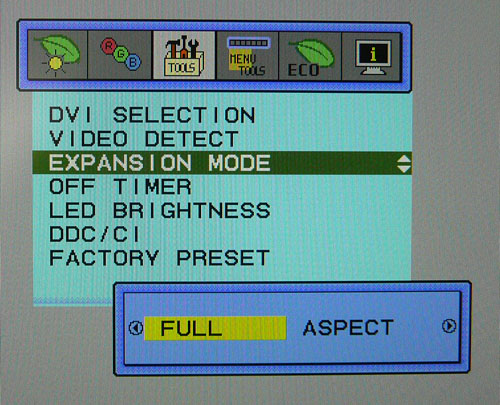
Aspect Ratio Control - The EX231Wp supports
aspect ratio control options through the OSD 'tools' menu as shown above. There are options
for 'full' and 'aspect'. A defined 1:1
pixel mapping mode is lacking here.
Preset Modes - There is a 'gaming' preset
mode available in the DV menu if you want it. This seems to make the image a
little brighter and might be useful to some.

Input Lag
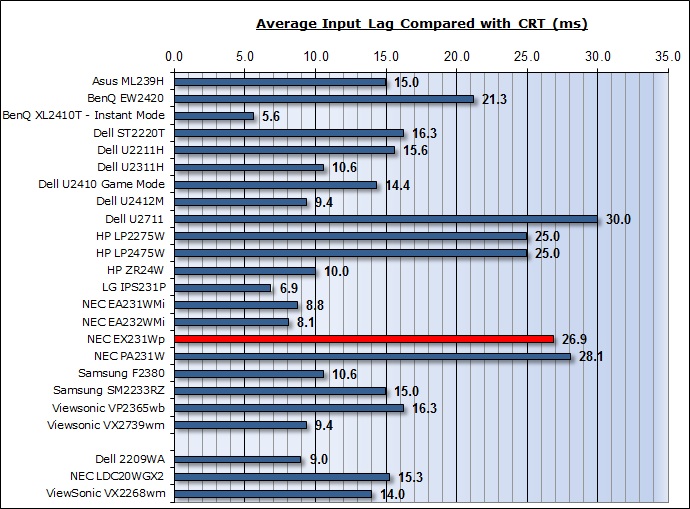
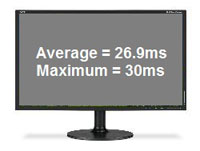

As usual I tested the
screen in clone mode with a CRT to determine the level of
input lag. This is
something which can put off some gamers and is a delay between graphics card and
monitor output. By hooking up a CRT you can show that the LCD lags behind
somewhat, which can affect users in some situations where they rely on the
screen image being as fast as their inputs (e.g. fast FPS shooting games).
Often, input lag is very low and probably wouldn't represent too much of a
problem in real terms.
The input lag of the EX231Wp was quite high
compared with many other models tested here, with an
average of 26.9ms and a maximum of 30ms. This was a medium level of lag and is
probably a reflection again of the fact that the screen is not really designed
with gamers in mind. The responsiveness of the panel is not that good, and input
lag is quite high as well. This won't be an issue for light gaming etc but the
combination of a medium input lag and slow pixel responsiveness could present a
problem for more serious gaming or FPS style games.

Movies and Video

The following summarises the screens performance
in video applications:
-
23"
screen size makes it a reasonable option for an all-in-one multimedia screen,
although quite a bit smaller than modern LCD TV's of course
-
16:9
aspect ratio is more suited to videos than 16:10 format screens, leaving
smaller borders on DVD's and wide screen content.
-
1920 x
1080 resolution can support true 1080 HD resolution content
-
Digital interface DVI supports HDCP for any encrypted and protected content
-
Additional DisplayPort interface available which is useful. Would have been
useful to feature HDMI as well here as it is increasingly popular and very
useful for external Blu-ray / DVD player connectivity.
-
Black
depth and contrast ratio are excellent thanks to the cPVA panel. Detail in
darker scenes should not be lost due to these measurements.
-
Dynamic contrast ratio is available and although operating quite slowly it
does work well and boosts DCR to over 7100:1.
-
'Movie'' preset mode is available from the preset menu. This boosted the
brightness a little but did make the image feel a little more washed out.
Might be useful if you want to set up a separate preset how you want for movie
viewing and keep the 'standard' preset available and set up for normal PC use.
-
Fairly
slow pixel responsiveness but should be able to handle fast moving scenes in
movies without issue.
-
Aspect
ratio control options available for external devices, offering options for
'fill' and 'aspect'.
-
Fairly
wide viewing angles thanks to cPVA panel technology meaning several people
could view the screen at once comfortable and from a whole host of different
angles. These are not as wide as some other VA panels and certainly a fair bit
more restrictive than IPS technology.
-
Good
ergonomic adjustments available from the stand allowing you to obtain a
comfortable position for movie viewing.
-
Thankfully no noticeable backlight leakage along any of the edges or corners
which has the potential to become distracting when watching movies, especially
where black borders are present.
-
No
integrated stereo speakers on this model or audio connections. No further
options for PiP or PbP.

Conclusion
The EX231Wp I
think is well summarised by it's 'Cool Office' name. Here you have a screen
which looks very attractive and sleek on any desk, featuring a very thin bezel
and stand and a slim profile from the side. It has a very wide range of power
saving options and features and extras like auto brightness control, human
sensing and ECO modes are very useful for those who are energy conscious or when
using many screens in an office environment. There is a very good range of
ergonomic adjustments as well which is useful in an office environment.
From a
performance point of view the default set up of the screen is moderate although
not great. It should suffice for general office use of course but switching to
sRGB mode and lowering the brightness would be advisable. Obviously if you can
calibrate the screen properly then you can get some excellent performance out of
the cPVA panel. The black depth and static contrast ratio are amazing and this
is a real strong point of modern VA panels. The screen can even handle movies
reasonably well with its extra DisplayPort connection, working DCR and excellent
black depth helping make it suitable for some video use. Sadly the viewing
angles are a little more restrictive than older PVA generations and certainly
more so than IPS panels which are increasingly popular in the market. Samsung do
seem to have improved the off-centre gamma shift though a little which is
pleasing. Pixel responsiveness and input lag are not the EX231Wp's strong points
though sadly.
The screen is
therefore an excellent choice for a business or home office environment I think
thanks to its decent performance and feature set. Gamers or heavy multimedia
users would probably be better looking elsewhere but the screen is fitting its
target market well I think. The screen retails for ~£275 (RRP of £294 GBP) which
does make it considerably more expensive than some other competing models. The
LG IPS231P for instance is a model quite well suited for office use at
retails for ~£155. The
ViewSonic VP2365wb is ~£220 and the new 24"
Dell U2412M is ~£290. This is quite a high price point for the new NEC
screen but it does have some useful extras and features which would make it well
worth a look for a decent office screen.
|
Pros |
Cons |
|
Excellent black depth and
contrast ratio from cPVA panel |
Some missing features like
D-sub and HDMI |
|
Very good feature set for
power saving including auto brightness, human sensor and ECO modes |
Slow pixel response times in
practice |
|
Good potential office monitor
thanks to feature and function set |
Medium input lag, not really a
gamer orientated screen |
|
 |
If you have enjoyed
this review and found it useful, please consider making a
small
donation to the site. |
